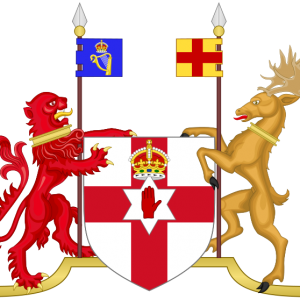Continuing with our discussion of the Cepharad, the migration of the house of Zarra can be traced by the markings of the Red Hand – signifying the hand that was tied with the scarlet thread, saying “this one came out first.”
Whereas, the house of Judah in the east would travel under the name Pheres (and the mixed multitude under their leadership as the Ashkenaz), the house of Judah in the west – the house of Zerach - would travel as the tribe of Eber (Heber) from whence the name Hebrew is derived. More historically, it is the name of the peoples called Iberian (Eberian) and is also the name of a certain peninsula that would at some point be called Spain and Portugal. On this land, this tribe of Eber named one of its cities Zaragossa (Zarah-gossa) and named its river the Ebro. The house of Zerach is known in the modern world as the Cepherad (Anusiym), often spelled Sefardi, and in the plural, Sefardiym, or Cephardiym.
History tells us that Gathelus died in Spain, and his widow Scota, along with her sons, left the land and voyaged northward to the island we now call Ireland. Once again, they took their name with them, calling their new home Hiber-land or Hibernia, and the islands to the north of it, the Hebrides. Then, with Eremon as their king, these descendants of Zara-Judah founded the Kingdom of Ulster shortly after the Exodus, and from that time to the present - some 3,400 years - the emblem of Ulster has been a red hand circled with a scarlet thread.
The first settlers in Ulster also used the Rampant Red Lion. In the official Arms of Northern Ireland we indeed see that it continues to hold an important place. Another point of interest in these Arms is that the Red Hand has as its background a six-pointed star of David (the Paleo Hebrew marker of dalet/dalet – the first dalet pointing toward the kingdom of heaven, the second dalet pointing toward the kingdom on earth).

Flag of Ireland
The flag of the province of Ulster (Ireland) showing David’s harp, the star of David under the crown with the red hand of Zarra in the middle, and of course the rampant red lion.
Consider again that the sons of Zerach were Zimriy (Zavdiy), and Eythan, and Heyman, and Kalkol (Calcol), and Dara: five of them in all. However, the name Dara at one point is referred to as Darda (Melakiym Ri’shon (1 Kings) 4:31). The Jewish historian Josephus referred to him as Dardanus (a Greek qualifier) and gives account of his travels northward across the Mediterranean Sea to the northwest corner of what is now called Asia Minor (Western Turkey). There, the tribe of Darda (Dardanus) established a Kingdom, which would later be called Troy, on the southern shore of that narrow body of water which bears his name to this day, the Dardanelles. Centuries later, according to Homer in his Iliad, Troy was destroyed in a war with the Greeks. The emblem of ancient troy – the rampant red lion, survived and traveled with the tribe northward into Europe. A large group led by Prince Brutus (et tu Bruti?), a direct descendant of Dardanus and Zara, lived in northern Italy for a while where they founded a royal line before moving on to Britain by way of Spain. They arrived in Britain around the year 1100 B.C.
Although Britain had a considerable population long before the arrival of these Trojans, their coming and the setting up of this transplanted Trojan Kingdom is the actual beginning of the British (brit = covenant, ish = man) nation.
As an aside, once again consider the progenitors of the tribes that would come to establish the populated world.
Bere’shiyth (Genesis) 10:22-24
The children of Shem; Elam, and Asshur, and Arphaxad, and Lud, and Aram. 23 And the children of Aram; Uz, and Hul, and Gether, and Mash. 24 And Arphaxad begat Salah; and Salah begat Eber.
Here, the talmidi of history can see the foundations of Elam (Persia, now Iran), Asshur (Assyria, now emerging Kurdistan), Arphaxad begets Salah who begets Eber (the father of the Hebrew nation); Lud (for whom the ancient city of London was originally named); and Aram (the father of the Aramaic language spoken throughout the ancient middle east following the collapse of Judea (now modern Syria). They are all cousins, eh?
Back to the rampant red lion. This symbol appears as the chief emblem in Scotland and is found in the Scottish Standard. Twenty Scottish clans have the rampant red lion in their coats of arms: the Earldom of Fife; Abernethy, Lord Saltoun; Dundas; Duff, Farquharson; Guthrie; Hepburn, Earl of Bothwell; Leslie; Lindsay; MacBain; MacIntosh; MacLachlan; Clanranald; Maitland, Earl of Lauderdale; Moncreiffe; MacDonald of Sleat; Shaw of Rothiemurchus; Spens of Lathallan; Stuart, Marquis of Bute; and Wemyss. The rampant red lion appears on the Royal Standard and on the shield on the Royal Arms. It appears as the ancestral emblem of the royal houses in Wales as well, and in the Netherlands in the provincial arms of South Holland, North Holland, Utrecht, Zeeland, Limburgh and Overijssel.
Finally, consider that the Cepharad has at its root the word cepher – the people of the numbered writing.
Baruch ha’bah ba’shem Yahuah Elohiym Tseva’oth.
(Blessed is he who comes in the name of Yahuah Elohiym Tseva’oth.)